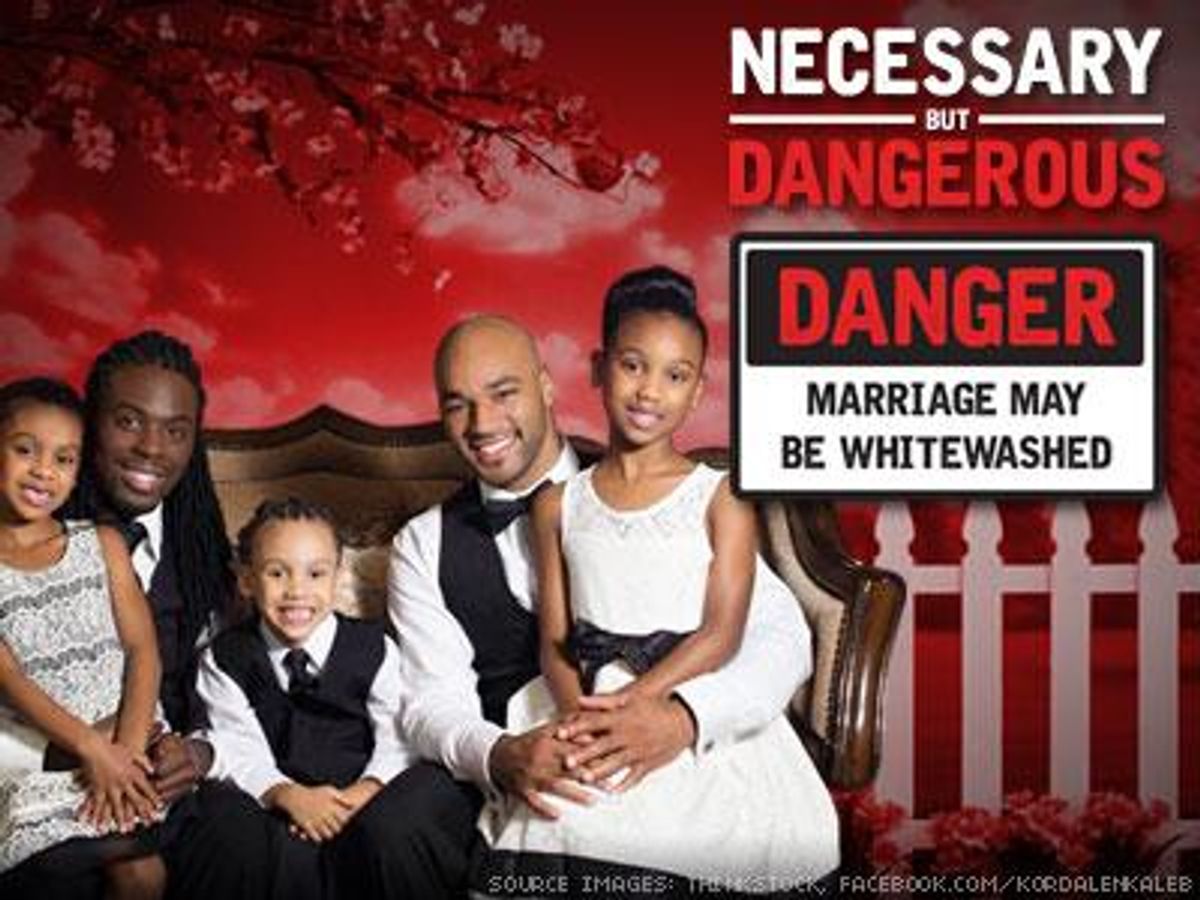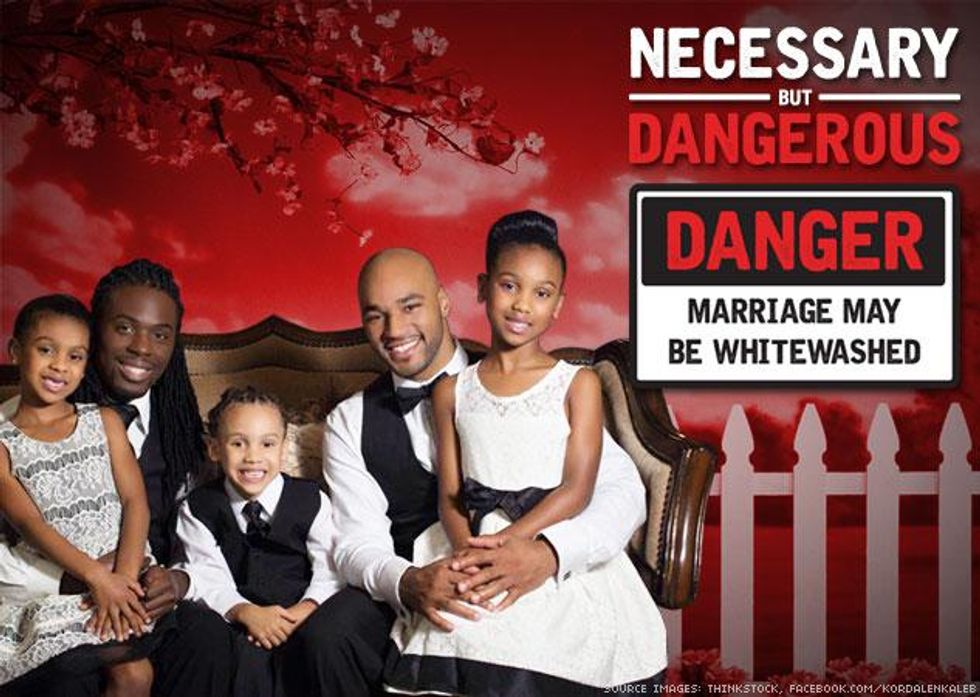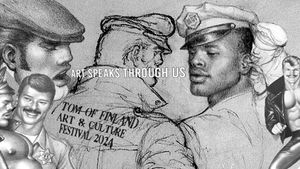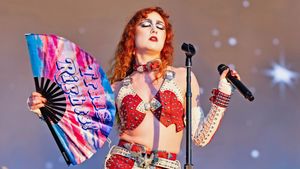 Kordale Lewis and Kaleb Anthony have it all.
Kordale Lewis and Kaleb Anthony have it all.
Three beautiful children, steady jobs, and a nice brick house with a perfect green lawn in Atlanta. A casual observer might say that this gay African-American couple is living one version of our American Dream, but unless you already follow them on social media (particularly Instagram) or keep up with Nikon and their commercial campaigns, you probably won't see Kordale and Kaleb (or any other gay couples of color) represented in mainstream advertising.
Nikon broke from the trend when it included the gay dads and their kids in an advertising campaign in January. Despite same-sex couples being statistically more likely to be interracial, commercial "gay marriage" is overwhelmingly whitewashed. And if the Supreme Court rules for nationwide legality of same-sex marriage, and with it comes a flood of celebratory ads, people of color could be left out of a defining moment.
"White people are not the only gay people in the world," says Anthony, who wants to see more inclusive advertising. "There are all sorts of people within the LGBT community who want their voice to be heard and we're trying to help advocate for them."
According to the data from the most recent U.S. Census analyzed by the Williams Institute at UCLA, same-sex couples are much more likely to be interracial or interethnic. In those Census results, 20.6 percent of same-sex couples were reported as being interracial/interethnic, more than two percentage points higher than the reported 18.3 percent of opposite-sex couples. So why, in light of the statistics that help prove the LGBT community is a very racially diverse one, is there still a whitewashing of LGBT-inclusive advertising? Advertising that should, in theory, also include happy nonwhite couples like Lewis and Anthony. The problem, some say, regardless of sexual orientation, lies deep within conventional media's already well established practices that more often than not manage to exclude people of color.
"It's no surprise that the representation of gay people is overwhelmingly white, since the representation of all peoples is overwhelmingly white," says Mireille Miller-Young, an associate professor in the University of California, Santa Barbara's Department of Feminist Studies. "This is something that critics have pointed out about the lack of opportunities for people of color to be in Hollywood or commercial media."
Racial exclusion in advertising is nothing new. Organizations like the Media Diversity Institute and the NAACP have fought against negative portrayals of minorities and for the inclusion of people of color for decades. But despite many efforts, a lot of progress remains to be made. Miller-Young points out that even if people of color do appear in the advertising campaigns of major commercial brands, they are usually represented with certain notions that go along with whatever minority group they belong to.
"The critique of people of color and queer people of color about media representations is somewhat the same," Miller-Young explains. "There's a lack of representation of people of color, but when they do appear, they are being used for particular ends to target those communities and get them to go along with a particular marketing campaign or vested interests. If they're going to show two queer Latino men, maybe it's an advertisement that has to do with immigration. If it's two black men, maybe it's about AIDS."
It's possible, she says, that the LGBT community is also being getting targeted based on preconceived notions. It's just that these notions more often than not revolve around successful, young, probably rich, handsome white men living a life that could easily mirror that of a happy straight couple.
The image persists no matter the target income level of consumers. Middle-class America's department store, JCPenney, included a real pair of gay dads in a mailer for Father's Day in 2012. In January of this year, famed high-end jeweler Tiffany & Co. featured a real-life same-sex couple in an advertisement that appeared in Out magazine -- the first time in the history of the 178-year-old company. In both examples, the men were white.
"Nowadays, the road to marriage is no longer linear, and true love can happen more than once with love stories coming in a variety of forms," said Tiffany & Co.'s vice president of North American PR, Linda Buckley in a statement to Elle. "The Tiffany engagement ring is the first sentence of the story that a couple will write together as they create a life that is deeply intimate and exceptional, which is the message we hope to convey through this campaign."
For including gay people in their ads, the companies both faced down backlash from some antigay corners of the world, including from the so-called One Million Moms. And LGBT people have certainly hailed them and others for not shying away.
Still, if love does come in "a variety forms," so should advertising, say critics. There are many examples of advertising with images of white gay people. In 2012, Gap ran a billboard with two adorable white men cozied up together in one of its iconic gray T-shirts. Banana Republic featured real-life celebrity couple Nate Berkus and Jeremiah Brent, who happen to be white, modeling a new line of clothes in 2014.
Some companies are making a conscious effort to change the face of their ads. Expedia, the popular travel booking website, ran a campaign recently with VisitBritain (a.k.a. the British Tourist Authority) called "Love is Great" that featured a real-life, interracial couple in ads for a contest to win a "romantic trip for two."
"Models were approached through a variety of channels and we really wanted to try and include real couples who identified as LGBT. Popular LGBT British cities such as London, Brighton, Birmingham, Manchester and Cardiff were included, showcasing a variety of experiences," says Paul Gauger, VisitBritain's head of international media and destination PR, about how "Love is Great" came to be. "When I was looking at the concept for the shoot, I particularly wanted to see that we were fully inclusive and would appeal to all members of the community. I wanted to see diversity and ensure we were embracing everyone. I want it to reflect real life."
All of these businesses are widely praised for taking the important step of making their advertising inclusive of LGBT people. But for many of the same reasons it's important to include LGBT folks, people of color want to see themselves in advertising as well.
When Nikon recruited Lewis and Anthony (and their daughters Desmiray and Maliyah and son Kordale) to be some of the faces of its"I Am Generation Image" campaign, it was after an Instagram selfie of the family's typical morning grooming routine went viral. Along with the love they got from the Internet for that photo also came a lot of hate -- both homophobic and racist.
"To be black and gay is a different feeling and experience," says Lewis. "I think when Nikon chose us, an African-American gay family, to be spokespersons in the 'I Am Generation Image' campaign, it opened up a lot of eyes and ears and gave us a voice to be recognized with equality and understanding. Letting folks know that 'Hey, these are people that have the same things, wants, and desires that any other normal couple would have.' Whether you are white and gay or black and gay. It's the same thing. The fact that they shed light on that is so phenomenal."
"Tell those companies to give us a chance," says Anthony. "Look at the Nikon commercial and all of the positive reviews received from displaying an African-American family within the LGBT community."
"When people start to see more ethnic communities stand up for ourselves and we're seen in a positive light more often, and doing normal things like regular people," says Lewis, adding, "Then the corporations will understand that there is a market for these minorities as well."


 Kordale Lewis and Kaleb Anthony have it all.
Kordale Lewis and Kaleb Anthony have it all.















































































